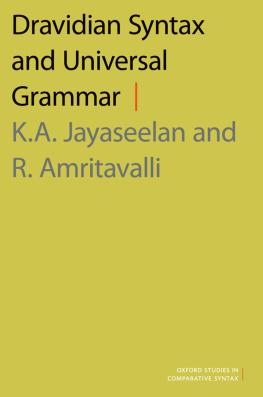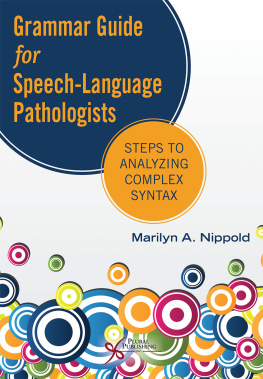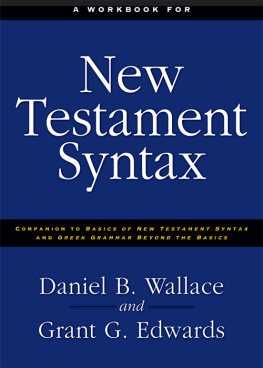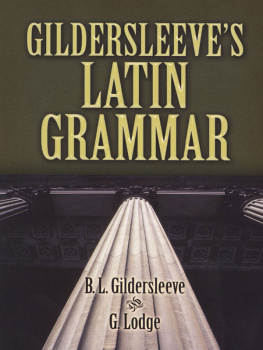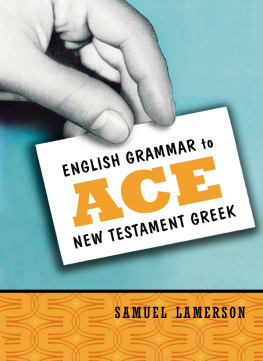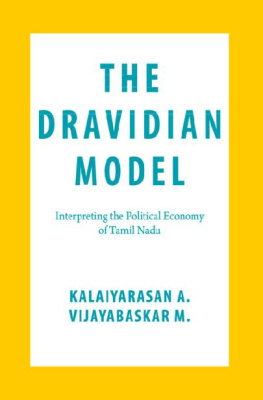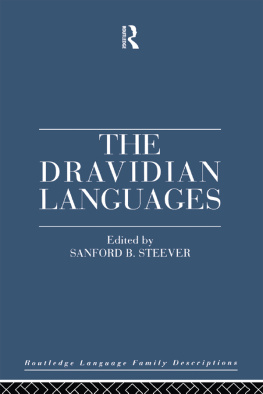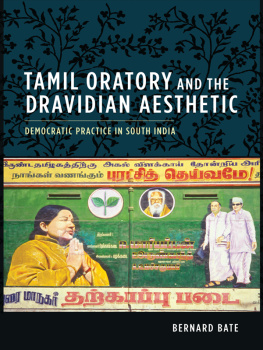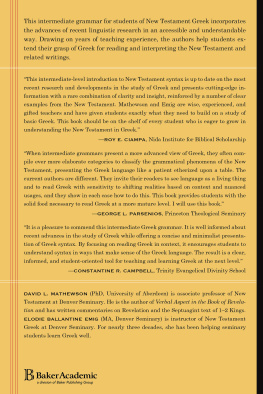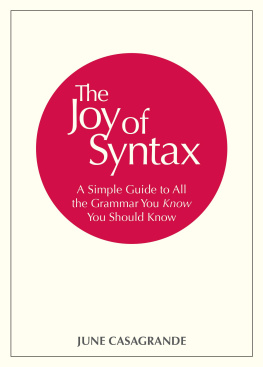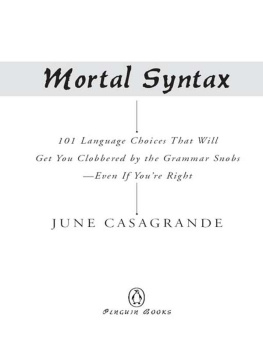Jayaseelan K. A. - Dravidian Syntax and Universal Grammar
Here you can read online Jayaseelan K. A. - Dravidian Syntax and Universal Grammar full text of the book (entire story) in english for free. Download pdf and epub, get meaning, cover and reviews about this ebook. year: 2017, publisher: Oxford University Press USA - OSO, genre: Home and family. Description of the work, (preface) as well as reviews are available. Best literature library LitArk.com created for fans of good reading and offers a wide selection of genres:
Romance novel
Science fiction
Adventure
Detective
Science
History
Home and family
Prose
Art
Politics
Computer
Non-fiction
Religion
Business
Children
Humor
Choose a favorite category and find really read worthwhile books. Enjoy immersion in the world of imagination, feel the emotions of the characters or learn something new for yourself, make an fascinating discovery.
- Book:Dravidian Syntax and Universal Grammar
- Author:
- Publisher:Oxford University Press USA - OSO
- Genre:
- Year:2017
- Rating:4 / 5
- Favourites:Add to favourites
- Your mark:
- 80
- 1
- 2
- 3
- 4
- 5
Dravidian Syntax and Universal Grammar: summary, description and annotation
We offer to read an annotation, description, summary or preface (depends on what the author of the book "Dravidian Syntax and Universal Grammar" wrote himself). If you haven't found the necessary information about the book — write in the comments, we will try to find it.
Dravidian Syntax and Universal Grammar — read online for free the complete book (whole text) full work
Below is the text of the book, divided by pages. System saving the place of the last page read, allows you to conveniently read the book "Dravidian Syntax and Universal Grammar" online for free, without having to search again every time where you left off. Put a bookmark, and you can go to the page where you finished reading at any time.
Font size:
Interval:
Bookmark:

Richard Kayne, General Editor
Movement and Silence
Richard S. Kayne
Restructuring and Functional Heads: The Cartography of Syntactic Structures, Volume 4
Guglielmo Cinque
Scrambling, Remnant Movement and Restructuring in West Germanic
Roland Hinterhlzl
The Syntax of Ellipsis: Evidence from Dutch Dialects
Jeroen van Craenenbroeck
Mapping the Left Periphery: The Cartography of Syntactic Structures, Volume 5
Edited by Paola Beninc and Nicola Munaro
Mapping Spatial PPs: The Cartography of Syntactic Structures, Volume 6
Edited by Guglielmo Cinque and Luigi Rizzi
The Grammar of Q: Q-Particles, Wh-Movement, and Pied-Piping
Seth Cable
Comparisons and Contrasts
Richard S. Kayne
Discourse-Related Features and Functional Projections
Silvio Cruschina
Functional Heads: The Cartography of Syntactic Structures, Volume 7
Edited by Laura Brug, Anna Cardinaletti, Giuliana Giusti, Nicola Munaro, Cecilia Poletto
Adverbial Clauses, Main Clause Phenomena and Composition of the Left Periphery: The Cartography of Syntactic Structures, Volume 8
Liliane Haegeman
Variation in Datives
Edited by Beatriz Fernndez and Ricardo Etxepare
Locality
Edited by Ian Roberts and Enoch Aboh
Aspects of Split Ergativity
Jessica Coon
A Comparative Grammar of Borgomanerese
Christina Tortora
Cross-Linguistic Studies of Imposters and Pronominal Agreement
Edited by Chris Collins
Japanese Syntax in Comparative Perspective
Edited by Mamoru Saito
Micro-Syntactic Variation in North American English
Edited by Raffaella Zanuttini and Laurence R. Horn
Functional Structure from Top to Toe: The Cartography of Syntactic Structures, Volume 9
Edited by Peter Svenonius
Chinese Syntax in a Cross-linguistic Perspective
Edited by Edited by Y.-H. Audrey Li, Andrew Simpson, and W.-T. Dylan Tsai
The Architecture of Determiners
Thomas Leu
Beyond Functional Sequence: The Cartography of Syntactic Structures, Volume 10
Edited by Ur Shlonsky
The Cartography of Chinese Syntax: The Cartography of Syntactic Structures, Volume 11
Edited by Wei-Tien Dylan Tsai
Argument Licensing and Agreement
Claire Halpert
Rethinking Parameters
Edited by Luis Eguren, Olga Fernndez-Soriano, and Amaya Mendikoetxea
Deconstructing Ergativity: Two Types of Ergative Languages and Their Features
Maria Polinsky

Oxford University Press is a department of the University of Oxford. It furthers the Universitys objective of excellence in research, scholarship, and education by publishing worldwide. Oxford is a registered trade mark of Oxford University Press in the UK and certain other countries.
Published in the United States of America by Oxford University Press
198 Madison Avenue, New York, NY 10016, United States of America.
Oxford University Press 2017
All rights reserved. No part of this publication may be reproduced, stored in a retrieval system, or transmitted, in any form or by any means, without the prior permission in writing of Oxford University Press, or as expressly permitted by law, by license, or under terms agreed with the appropriate reproduction rights organization. Inquiries concerning reproduction outside the scope of the above should be sent to the Rights Department, Oxford University Press, at the address above.
You must not circulate this work in any other form and you must impose this same condition on any acquirer.
Library of Congress Cataloging-in-Publication Data
Names: Jayaseelan, K. A., author. | Amritavalli, R., author.
Title: Dravidian syntax and universal grammar : Jayaseelan-Amritavalli papers / K.A. Jayaseelan, R. Amritavalli.
Description: New York, NY : Oxford University Press, [2017] | Series: Oxford Studies in Comparative Syntax
Identifiers: LCCN 2016025663 | ISBN 9780190630225 (cloth : alk. paper) | ISBN 9780190630249 (updf) | ISBN 9780190630256 (ebook)
Subjects: LCSH: Dravidian languagesSyntax. | Dravidian languagesGrammar, Comparative. | Generative grammar.
Classification: LCC PL4604 .J29 2016 | DDC 494.8dc23
LC record available at https://lccn.loc.gov/2016025663
K. A. Jayaseelan
K. A. Jayaseelan
K. A. Jayaseelan and R. Amritavalli
K. A. Jayaseelan
K. A. Jayaseelan
R. Amritavalli
K. A. Jayaseelan
K. A. Jayaseelan
R. Amritavalli
K. A. Jayaseelan
R. Amritavalli
R. Amritavalli
R. Amritavalli and K. A. Jayaseelan
R. Amritavalli and Deepti Ramadoss
K. A. Jayaseelan
R. Amritavalli
R. Amritavalli and K. A. Jayaseelan
K. A. Jayaseelan
K. A. Jayaseelan
K. A. Jayaseelan
R. Amritavalli
R. Amritavalli
K. A. Jayaseelan
R. Amritavalli
R. Amritavalli
K. A. Jayaseelan
K. A. Jayaseelan
K. A. Jayaseelan and M. Hariprasad
The papers included in this volume are a selection from the work on Dravidian done by the two authors over the last thirty yearsthe earliest paper here is dated 1984.
A brief introduction to Dravidian may be useful to readers who are unfamiliar with this group of languages. The Dravidian languages are spoken principally in southern India. But there are a few isolated Dravidian languages in the sub-Himalayan belt, and one has been discovered in Pakistan. Altogether 26 languages have been counted. But the principal Dravidian languages are Tamil, Telugu, Kannada and Malayalam. These four languages, each with its own writing system and long literary traditionthe Tamil literary tradition dates back to 500 BCE or earliercurrently have millions of speakers, and are sometimes referred to as the major Dravidian languages. These are the languages that figure in this volume.
There are typological descriptions of these four languages, which the reader who wishes to have an over-all picture of any one of them may wish to consult: Krishnamurti and Gwynn (1985) (Telugu), Lehmann (1989) (Tamil), Sridhar (1990) (Kannada), Asher and Kumari (1997) (Malayalam). For information about the geographical spread of the Dravidian languages, a list of these languages, speaker statistics, and the proto-history of Dravidian, the most accessible source is Krishnamurti (2003). A principled typology of just the anaphoric systems of the above-mentioned four principal languages can be found in Lust et.al. (2000). A useful bibliographical tool for the Dravidian scholar is Ramaiah (19942005), a six volume bibliography of Dravidian languages and linguistics.
The papers in this volume are grouped into sections under five thematic heads. We now give a brief indication of the main concerns of these sections, reserving a more detailed discussion of them to the mini-prefaces that we give at the beginning of each section.
A commonly noted typological feature of the Dravidian languages is that they are head-final but that they otherwise have free word order. We deal with free word orderalways foregrounded in typological accounts of Dravidianin the papers in Section I of this volume. But we do not go along with a claim which has sometimes been made, that these languages have no neutral word order. Instead, the emphasis is on some hitherto unnoticed semantic properties of Dravidian scrambling. These are then related to parallel facts regarding non-canonical word orders in some OV languages of Europe; and we proposeas a result of these cross-linguistic comparisonswhat we hope is a deeper explanation of this phenomenon in terms of the universal functional architecture of the clause.
Font size:
Interval:
Bookmark:
Similar books «Dravidian Syntax and Universal Grammar»
Look at similar books to Dravidian Syntax and Universal Grammar. We have selected literature similar in name and meaning in the hope of providing readers with more options to find new, interesting, not yet read works.
Discussion, reviews of the book Dravidian Syntax and Universal Grammar and just readers' own opinions. Leave your comments, write what you think about the work, its meaning or the main characters. Specify what exactly you liked and what you didn't like, and why you think so.

